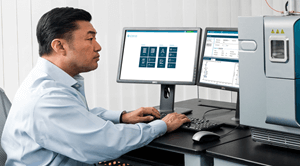Factors that affect the reproducibility of your assay As scientists, we know our experiments must be reproducible. Without it, there is always doubt as to whether our data interpretations and conclusions are truly sound. With LC-MS/MS quantitative methods, high...
Tags
Overcoming uncertainty in your PFAS analysis
Just like gum on the bottom of a shoe, the existence of per- and poly-fluorinated alkyl substances (PFAS) in our environment is a sticky one. If you’re in the field of environmental testing, then you’re all too familiar with the threat these substances have on public health. While we have learned a lot about them over the years, there is still much more to understand. With the right detection methods, we can gather the information we need to empower us to make informed decisions on reducing the risks they impose.

6 Signs it’s time for a new vendor
A lab’s success depends on many factors from instrument quality to efficient operations, including being partnered with the right vendor. A vendor is more than just a supplier. They should provide you with a high-level quality of support in maximizing the lifespan and performance of your systems, reducing downtime, enhancing ROI and more. How do you know if you’re partnered with the right one? Here are six signs it might be time to find someone new.

Selecting an LC-MS system for quantitation of pharmaceutical drug development
We understand you are busy, needing to prioritize running instruments, reporting results and managing your laboratory to meet deadlines. We created a solution guide to explain how SCIEX systems fit in the drug development pipeline to save you time evaluating options.

Nitrosamines: Where are we now?
Nitrosamines are a large group of N-nitroso compounds that share a common functional N-N=O group. They are produced by a chemical reaction between a nitrosating agent and a secondary or tertiary amine. Back in 2018, nitrosamines suddenly found themselves in the spotlight when they were unexpectedly detected in medications for high blood pressure. Since then, they have been found in several other prescription medications, including those for heartburn, acid reflux and diabetes, resulting in manufacturers recalling some common medications.

Celebrating customer experience: Insights from SCIEX leaders
Introduction Customer Experience Day (CX Day) is a special occasion for SCIEX, celebrated every first Tuesday in October. It’s a day dedicated to recognizing the incredible value of our customers and the relentless dedication of our associates who strive to make...

PFAS analysis in food: a robustness study in sensitivity and stability
The combination of per- and polyfluoroalkyl substances (PFAS) testing, trace-level regulatory requirements and complex MS applications can be intimidating. In a recent webinar, now available on demand, SCIEX PFAS expert Craig Butt demonstrated how the new SCIEX 7500+ system can help make PFAS testing easier.

Your success and voice go a long way!
At the heart of everything we do is ensuring that your workflows and team are empowered to achieve optimal results with your SCIEX instruments, software, consumables, and services. Every interaction with SCIEX is designed to support your success through the dedication...

FDA’s final rule on LDTs: what does it mean for clinical laboratories?
On April 29, 2024, the U.S. Food and Drug Administration (FDA) announced a final rule regulating laboratory developed tests (LDTs) as in vitro diagnostic devices (IVDs) under the Federal Food, Drug and Cosmetic Act (FD&C Act). This rule amends FDA’s regulations to state that in vitro diagnostic tests “manufactured” by clinical laboratories fall within the scope of the FDA regulatory oversight and is poised to dramatically shift the way clinical diagnostic laboratories in the United States develop and offer LDTs in the future. Read this blog post for a basic overview of the scope, intent and implications of this final rule, including the regulatory requirements, exceptions and timeline for implementation.

LC-MS system replacement: Are you ready?
Meeting deadlines in a bioanalysis laboratory can be a big challenge. Older, less sensitive and less reliable LC-MS systems make it even more difficult. Even the disruption caused by the installation and validation can be disconcerting and delay decisions. Does this sound familiar?

An overview: LC-MS analysis of targeted protein degraders and their metabolites
Targeted protein degraders (TPD) are a relatively new therapeutic modality that opens the potential to target disease-causing proteins. These disease-causing proteins have been highly challenging for traditional small-molecule therapeutics to treat, making TPDs an exciting new therapeutic modality.

A Fresh Approach to Food Safety
The EU Reference Laboratory (EURL) for Fruits and Vegetables in Almería is responsible for a network of around 200 laboratories which provide essential surveillance and monitoring to ensure the safety of foodstuffs available across Europe. The EURL provides proficiency testing and method development for these official laboratories, ensuring rigorous screening to avoid harmful chemicals entering the food chain

The Only Solution You Need for Fast MetID
If you work in the breakneck world of therapeutic development, then you probably don’t even have time to read this blog (but we thought we would write it anyways, just in case). Drug metabolism samples are coming into your lab fast and furious. You need to turn them around in hours so that chemists and biologists can optimize the effectiveness of the therapeutic candidate. Time for lunch? We don’t think so!

How Easy Is It to Relocate a Mass Spectrometer?
When you’re in the process of moving your lab, across the corridor or to another country, there’s a lot to think about. Adding to the stress, there’s not always a lot of time to plan, or budget allocated for the process, especially in the case of unexpected urgent maintenance work.

The Key to Measuring Chemical Dyes in Food is LC-MS/MS
Adding colorful dyes to food is nothing new. In the early 19th century, for example, it wasn’t uncommon for manufacturers to add chalk to white bread, thicken milk with a lead compound, and inject red dye into meat in the quest for a fresher appearance1. Fast forward to the 21st century, however, and along with mass spectrometry, food standards have come a long way. Foods now must pass muster according to standards set by government regulators or else risk fines and punishment which can be costly for the manufacturer. To support these measures, are agencies such as the US-FDA, EFSA, and others which have banned some colors due to their toxic and carcinogenic nature which brings me to mass spectrometry analysis. Discover more when you read the following application note, “LC-MS/MS Analysis of Emerging Food Contaminants,” in which researchers used the ExionLC AD with a Phenomenex Column for sample separation followed by MS/MS detection with the SCIEX X500R QTOF system.

What is your Method for Separating Challenging Polar Molecules?
From small ions like phosphate, herbicide degradation to metabolites, oligosaccharides, peptides, and proteins. How is your lab analyzing polar molecules? The reason I ask is there is a saying, if you have a charged or polar molecule, look to capillary electrophoresis (CE) first. While liquid chromatography (LC) is an ideal front-end separation tool for many types of molecules, as the following poster points out, “From Small to Very Large, Orthogonal, Sensitive Polar Molecule Analysis by CESI-MS,” there are some situations that call for CE over LC analysis. For those of you that are not familiar with CESI-MS, it is the combining of CE separation with electrospray ionization, into one dynamic process, within the same device.

The Trouble with PFAS in Drinking Water
There has been a string of news articles concerning polyfluorinated alkyl substances (PFAS) in drinking water these days, and I must say, they have my attention. Here is the thing, when you think of drinking water in the United States, for example, crystal clear lakes, rivers, and groundwater along with effective water treatment come to mind. On the flip side, as safe, some supplies may be there are communities such as that of Flint, Michigan, which have been dealing with lead filled pipes for far too long. Contamination was so bad there that residents were provided bottled water for drinking purposes as the state decided who was responsible for replacing the affected water lines.

SWATH Acquisition – Master of All Trades
SWATH® Acquisition is an innovative strategy for acquiring data on a TripleTOF® mass spectrometer. In a previous blog, we learned how SWATH works. Now let’s learn what it can do for different applications:

The Power Behind LC-MS for Quantifying mAb Therapeutics
Quantitation of monoclonal antibodies (mAbs) in biological fluids is important during all stages of antibody drug development. First developed in the 1970s, therapeutic mAbs have both research and medicinal impact as they can be used for diagnosis and treatment of a wide variety of diseases, and have a high level of specificity.

Data Independent Acquisition Mass Spectrometry with the Power of SWATH
There are many different methods in use today to acquire data on a mass spectrometer, but few have generated as much buzz in recent years as SWATH technology. First reported 5 years ago by Ruedi Aebersold and his group1, SWATH® Acquisition on a TripleTOF® instrument has rapidly become one of the premier acquisition strategies for identification and quantitation of complex samples. But what exactly is SWATH and why is it so powerful? In order to answer these questions, let’s first take a step back and look at the larger picture.

Volumetric Absorptive Microsampling and the SCIEX 6500+: A Pre-Clinical Case Study for the Biotherapeutic Exenatide
In an effort to Replace, Refine, and Reduce the number of animals used for pre-clinical research, several microsampling strategies have been implemented which allow for the consolidation of satellite TK and main study groups. In addition to the ethical gains driven by these 3Rs, microsampling has the potential of increasing scientific value since it becomes feasible to directly correlate exposure, toxicological effects and pharmacological response in the same individual

Say Goodbye to MetID Headaches, Say Hello to Automated Large Molecule Catabolism Processing
Is your mind swimming with large molecule catabolism data? Do you spend hours manually processing through complex spreadsheets to match your data with theoretical biologic catabolites? Are you wasting precious time by drawing out and processing your therapeutic peptide as a small molecule? Are you worried that you could be missing something?

Using the X500R QTOF System and SCIEX OS to Identify and Quantify Food Residues
Farmers use pesticides to protect crops from insects and disease as pesticides are necessary to create the volume of food that our population requires. Without them, we would not be able to grow enough crops to feed the world—they are a necessary evil. Government agencies such the Food and Drug Administration (FDA) in the United States and pesticide manufacturers, however, work hard to educate farmers on how to minimize their use. However, sometimes farmers add too much which leaves a residue. Upon harvest, farmers wash the fruit and vegetables. Once complete the crop then makes its way to the wholesaler and eventually, the supermarket. Even so, there may still be pesticide residue on the produce, which is why government agencies randomly pull produce from store shelves for testing of maximum residual limits (MRLs) and we are encouraged to wash our food before consuming it

The World Has its Eyes on Precision Medicine
What if we could understand and then treat diseases on an individualized level, in a way that was tuned to a person’s individual biology? Not in a futuristic, ‘wave a high-tech scanner across a person’s body’ way, but in a legitimate ’I can run a lab test and know the best action to take’ way. This is the promise of Precision Medicine, to deliver the right treatment to the right patient, at the right time, predicting more accurately which treatments will work for certain groups of patients, in contrast to the pervasive one-size-fits-all approach. More specifically, if we could provide a comprehensive report at the molecular level of an individual (based on genome, proteome, or metabolome profiles), a physician could be much better informed to make optimal treatment decisions. And if we could track these profiles over time, a person could adjust their lifestyle to focus on long-term wellness.

Setting Records with Fast Glycan Technology
There is a lot of talk going around in the lab, and it has to do with the newly released Fast Glycan Labeling and Analysis technology. Where once research analysts needed to set aside days to perform glycan analysis, now takes an hour or so. Glycans are immediately identified by the software – so no need for data interpretation. That’s up to 5x faster than HILIC.

Confidently Screen For Your Usual Suspects—Plus Those That May Be Lurking Within Your Food Sample
The demand on labs throughout the world to run their triple quadrupole mass spectrometers to maximum capacity is ever increasing. Instruments are often operated continuously to ensure regulatory screening requirements are satisfied for targeted pesticides, mycotoxins, and veterinary drugs. Whether you are a commercial lab or a food manufacturer, the quality of the data you acquire is vital to your business. You must be certain that the last batch of strawberries you tested conform to pesticides regulations—your targeted list of usual suspects.

Turning up the Speed on Forensic Toxicology Screening and Quantitation
Working in a forensic lab means technicians want super high-quality data in ultra-fast time. Yet, how do you go about detecting an unlimited number of analytes without re-injecting the sample all while new targeted compounds are being added to the screened panel? In the following application note, “Ultra-Fast Forensic Toxicological Screening and Quantitation in Under 3 Minutes Using SCIEX X500R QTOF System and SCIEX OS 1.0 Software,” researchers set out to achieve a fast method that could detect an unlimited number of analytes with all information afforded mass accuracy, LC retention time, and MS/MS spectral library matching.

What Food Safety Trends are Coming This Year?
As we settle into 2017, I can’t help but reflect on the previous year’s food safety. Take for example the legislative changes meant to contain contamination outbreaks like those happening in places like China, Singapore, and New Zealand. Over the past year, we have developed new methods that detect antibiotics in poultry feed, LC-MS/MS Analysis of Emerging Contaminants, and help set food standards in China. All the while developing more sophisticated technology to keep up with testing demands.

Never Stop Learning with SCIEX University
Did you know that when you log into SCIEXUniversity, you have 24/7 access to educational tools? Simply click on the Support from SCIEX.com and select SCIEXUniversity. Here you will find more than 100 newly revamped courses developed by in-house experts, scientists, and researchers who, just like you, are interested in the next scientific breakthrough. Whether you are a beginner mass spec user or have years of experience, these online and on-site courses are designed with you, the user, in mind. What is more is that the course catalog offers self-paced training and certification programs to help you get better acquainted with software, instrumentation, and workflows

Fast and Simultaneous Analysis of Ethanol Metabolites and Barbiturates
While most analytes in forensic applications analyze well with positive ionization, there are analytes that show better ionization efficiency with negative ionization, for example, acidic compounds. These analytes include ethanol metabolites such as ethyl glucuronide (ETG), ethyl sulfate (ETS), and the barbiturates such as amobarbital, butabarbital, butalbital, pentobarbital, phenobarbital, and secobarbital.

It’s a Point and Click World with the X500B QTOF System for Biologics Characterization
Did you know the X500B QTOF system makes point and click workflows for Biologics Characterization possible on your mass spectrometer? The newly-designed SCIEX OS software interface brings to life fluid navigation and ease of use so you can keep moving forward on your scientific discoveries. In fact, it’s so simple to learn and operate that you and your team can be up and running faster than you might expect.